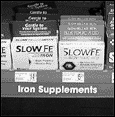Protein Discovery Leads Researchers to New Suspect in Iron Anemia
By Kathy Scalise, Public Affairs
Posted February 24, 1999
 Iron deficiency isn't everything when it comes to explaining anemia, research finds. Julia Sommer photo. |
The researchers discovered a protein, hephaestin, that appears critical for moving iron to the bloodstream. This protein contains copper and cannot be produced in the absence of copper. Thus in some cases, having too little copper present even with an ample iron supply might cause anemia, said the lead author on the paper, Assistant Professor Christopher Vulpe of the Division of Nutrition and Toxicology in the College of Natural Resources.
The new protein may also help explain what Vulpe describes as the number one inherited disease in Caucasians, hemochromatosis. It results from too much iron in the body and can cause diabetes if it kills insulin-producing cells in the pancreas, or "iron heart" if too much of the metal accumulates in that organ and causes cardiac arrest.
Vulpe's collaborators on the project included researchers from UC San Francisco, the University of Utah and the University of Queensland in Australia.
Hephaestin was isolated from mice and named after the Greek god for metal-working, Hephaestus. The protein is produced by the gene Heph, also discovered by the researchers and reported in the Nature paper, and is tethered to the membrane of intestinal cells. The researchers suspect it is a "multi-copper ferroxidase" protein that contains copper and works on iron molecules.
Vulpe led the original study while a postdoctoral fellow in the laboratory of Professor Jane Gitschier of UCSF. Gitschier said in a recent UCSF statement that "more work needs to be done to determine if and how often genetic defects in iron transport occur in humans."
In describing the possible role of the new protein, Vulpe traced the path of iron through the body.
Iron, he said, usually originates in the food supply, either as "heme," a cage of iron that transports oxygen in blood and comes mainly from meats, or as "free" iron from other sources. Both kinds of iron are processed by the gut -- stomach and intestine -- where they are converted by means not well understood to a form of iron readily used by the body. Finally, the iron winds up in the intestinal epithelial cells, ready for export to red blood cells, muscle tissue and organs.
But somehow "it has to get out of the gut and into the bloodstream," said Vulpe.
This is particularly difficult, he said, because the so-called "hydrophobic" intestinal membrane wants to reject the charged iron molecule.
So hephaestin comes into play. Probably acting as a helper molecule forming a complex with a yet unknown transport protein, it allows iron to make its way through the membrane.
In fact, hephaestin may act like an "on/off" switch to control the flow of iron into the body, said Vulpe. Perhaps in the presence of hephaestin, more iron is pumped into the blood, and when hephaestin stops production, the pumping also soon halts.
While a certain amount of iron is vital for survival, about 10 percent of infants and women of childbearing age in the U.S. -- about 8.5 million people -- are iron deficient. Many other people suffer from having too much iron circulating in the body, a syndrome called hemochromatosis, which can also have toxic effects.
When the body functions correctly, excess iron remains trapped in the intestine and is harmlessly excreted. Disease results only after too much iron escapes from the intestine and into the blood.
The UC researchers plan to investigate whether hephaestin plays a role in hemochromatosis.
They suspect improper regulation of the Heph gene may result in the relentless pumping of iron into the body in this disease.
"The dogma of most physicians is that genetics contributes absolutely nothing to iron deficiency, and it almost entirely results from insufficiency of iron in the diet or blood loss," said Vulpe. "But I think of it in terms of susceptibility. If the genes involved along the pathway aren't working correctly, it could make you more susceptible to anemia or resistant to treatment with oral iron, [which are] big clinical problems."
Vulpe said that although the amount of iron given for anemia is often astronomical, and much more than the body should need if everything were working correctly, some people are "iron resistant" and do not respond to even high doses of additional iron.
![]()
![]()
February 24 - March 2, 1999 (Volume 27, Number 24)
Copyright 1999, The Regents of the University of California.
Produced and maintained by the Office of Public Affairs at UC Berkeley.
Comments? E-mail berkeleyan@pa.urel.berkeley.edu.